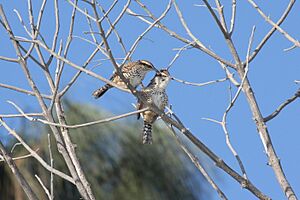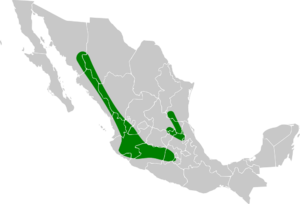Spotted wren facts for kids
Quick facts for kids Spotted wren |
|
|---|---|
 |
|
| Conservation status | |
| Scientific classification | |
| Genus: |
Campylorhynchus
|
| Species: |
gularis
|
 |
|
The spotted wren (Campylorhynchus gularis) is a small, active bird that lives only in Mexico. It belongs to the Troglodytidae family, which includes many types of wrens. This bird is known for its unique spotted chest and lively behavior.
Contents
About the Spotted Wren's Family
Scientists study how different animals are related. The spotted wren was once thought to be the same species as Boucard's wren. But, new studies show they are not closely related at all. The spotted wren is a unique species and does not have any subspecies.
What the Spotted Wren Looks Like
The spotted wren is about 17 cm (6.7 in) long. It weighs between 28.3 to 31 g (1.00 to 1.09 oz), which is about as much as a few quarters.
Colors and Markings
Adult spotted wrens have a reddish-brown top of the head. Their shoulders and back are also reddish-brown with dull black and light yellow-brown spots. Their tail is gray-brown with darker stripes.
They have a white stripe above their eye, like an eyebrow. A brown stripe goes through their eye, and their cheeks are a light yellow-white color. Their chin, throat, and chest are off-white. The sides of their chest have blackish spots, which gives them their name! Their belly and lower sides are light yellow-brown with faint stripes.
Young Wrens
Young spotted wrens look a bit different. Their head is dull black, and the spots on their back are not as clear as on adult birds. Their chest is pale yellow-brown and does not have the spots that adults have.
Where the Spotted Wren Lives
The spotted wren lives in two main areas of Mexico. These areas are separated by land where the bird cannot live.
Western Mexico
In the west, you can find them from southeastern Sonora state. They live south to western México state and western Morelos state.
Eastern Mexico
East of that area, they live from southern Nuevo León and southwestern Tamaulipas. They also live in central San Luis Potosí south to Hidalgo state.
Their Home Environment
Spotted wrens live in several different types of places. They can be found in dry oak forests and pine-oak forests. They also live in areas with shrubs and cactus plants. Sometimes, they live on rocky hillsides with palm trees. They usually live at heights between 800 and 2,500 m (2,600 and 8,200 ft) above sea level. In Colima state, they can be found even higher, up to 3,000 m (9,800 ft).
How the Spotted Wren Behaves
What the Spotted Wren Eats
Spotted wrens are very active when they look for food. They usually search in small groups. They often look for food on or near the ground. However, they can also search as high as 15 m (49 ft) up in trees.
They poke around in the cracks of tree bark. They also search among plants that grow on other plants, called epiphytes. They look under rocks for small insects and other creatures without backbones. They also eat plant material, like cactus seeds. Sometimes, they even eat small lizards!
Reproduction and Nests
Not much is known about how the spotted wren breeds. Like other wrens in its family, it builds a dome-shaped nest. This nest has an entrance on the side. It seems that they lay two to four eggs at a time.
Spotted Wren Sounds
The song of the spotted wren has been described in a few ways. Some say it sounds like "a series of harsh churring notes." Others describe it as "a series of unmusical gurgling phrases." Their call sounds like "a gruff 'cheh-cheh-cheht'."
Spotted Wren Population Status
The IUCN (International Union for Conservation of Nature) has looked at the spotted wren's population. They have decided that it is a species of "Least Concern." This means that the bird is not currently in danger of disappearing. Its numbers can change. It might be quite rare in some places, but very common in other areas where the habitat is good for them.


